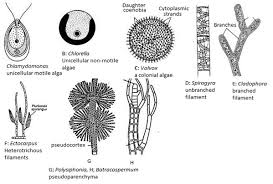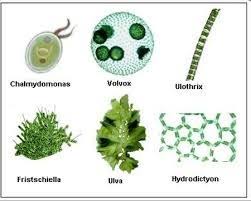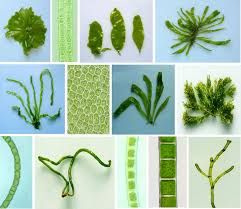Algae belong to the Kingdom Protista, alongside protozoa. Previously, they were classified with plants due to their photosynthetic autotrophic nature—possessing chlorophyll and chloroplast giving them a superficial resemblance to plants. However, since their gametes lack protective cells, they are no longer classified as plants.
This article focuses on the morphology of algae. Although simple in structure and lacking differentiation, algae display a remarkable diversity in size and appearance.
Their size ranges from simple microscopic forms to giant thalli extending several meters in length, as seen in kelps. Algal morphology varies from simple unicellular forms to more complex thalli, such as those found in seaweed.
Algae are widely distributed in nature, occurring wherever there is abundant water and sunlight. They thrive on wet rocks, moist ground, and pools of water, and even inhabit harsh environments.
Read Also: Is Providing Shades on a concrete fish tank necessary? Find out
Algal Morphology Overview

The study of algae is known as “Phycology,” and individuals who specialize in it are referred to as “Phycologists” or “Algologists.”
The body of an alga is called a thallus. In unicellular algae, the thallus is simple, consisting of a single cell. All multicellular organisms begin their life as single cells.
As a cell divides and its daughter cells form a packet enclosed in a mucilaginous mass, a colony is formed. When cell division occurs continuously in the same plane, with daughter cells sticking together, a row of cells, or filament, is produced.
In some cases, certain cells of a filament divide vertically followed by transverse divisions, forming a branched filamentous thallus. When all cells of a filament undergo division in both vertical and horizontal planes, a sheet of one or more cell layers is formed.
Multicellular thalli may exhibit more complicated differentiation, as observed in seaweed. All multicellular algae pass through these developmental stages.
The following sections describe specific examples of the basic types of thallus in algae. It is important to note that these forms are not found in every algal division, as some are predominantly multicellular, others are filamentous, and some include only unicellular forms. The increasing complexity of thallus morphology reflects the evolutionary progression of algae.
Read Also: Will Tanker Water cause Harm on your Fish Pond? Find out
Types of Algal Forms

Algae can be classified into several morphological types: unicellular, colonial, filamentous, heterotrichous, thalloid, and polysiphonoid forms. Each of these types is explained below.
A. Unicellular Forms
1. Anacystis
This form consists of single cells that are cylindrical, either short or long, and sometimes very long and snake-like. Cells divide by constriction, and the two daughter cells may separate or rarely remain together to form a two-celled filament. Individual cells may have a mucilaginous cover, and several cells may be enclosed in a common, colorless mucilage, giving the appearance of a colony.
2. Chlamydomonas
This unicellular alga has a nucleus and a cup-shaped chloroplast containing a pyrenoid. The chloroplast features 2 to 3 rows of red-colored fatty granules, known as the eyespot or stigma, which helps the alga respond to light. The cell wall is firm, and a small contractile vacuole is found at the base of each flagellum.
Under partially dry conditions, Chlamydomonas divides, and daughter cells without flagella remain enclosed in a common mucilage mass. This colony is known as the palmella stage. Upon exposure to water, individual cells develop flagella and swim away, signaling the transition seen in Volvox colonies.
B. Colonial Algae
When a cell divides and the daughter cells remain together within a common mucilage mass, a colony forms. Some colonies are large enough to be visible to the naked eye.
1. Microcystis
A colonial alga common in polluted ponds and lakes, Microcystis forms large colonies that can be visible without a microscope. These colonies float on the water’s surface due to the presence of gas vesicles inside individual cells.
2. Volvox
Volvox forms spherical colonies that are large enough to be seen with the naked eye. Each colony contains 1,000 to 5,000 cells arranged on the outside of a mucilaginous ball called a coenobium. The number of cells in a coenobium is fixed at formation and does not increase.
Volvox colonies exhibit two types of cells: vegetative (somatic) cells and gonidia (reproductive cells). Cytoplasmic connections, or plasmodesmata, are present between the cells. Some cells remain vegetative, while others take part in reproduction, showcasing a division of labor critical in the development of multicellular organisms.
C. Heterotrichous Forms
In some filamentous algae, vertical cell divisions result in branching, giving the filament a bushy appearance. Some algae feature a prostrate system at the base, which remains attached to the substratum, while an erect system of vertical branches arises from it. This morphology is referred to as a heterotrichous habit.
1. Draparnaldiopsis
This heterotrichous alga exhibits differentiation in its body structure. The prostrate system is reduced, and the main axis contains long internodal cells alternating with short nodal cells. The nodal cells bear short branches, and some side branches develop into long, colorless hairs or setae.
The main axis produces numerous long, multicellular, colorless rhizoids at the base, forming a cortex that helps attach the alga to the substratum.
2. Fucus
Fucus is a brown alga found on rocky sea coasts in temperate regions. The body of Fucus is large, about half a meter in length, with a basal discoid holdfast, a short stipe, and long, flat, dichotomously branched fronds or blades. The dichotomous branching pattern has branches of approximately equal length. Air bladders at the tips of the blades allow the plant to float.
D. Polysiphonoid Forms
Polysiphonoid algae are more complex than the forms described above and are typically found in red algae, such as Polysiphonia, which inhabits marine environments.
1. Polysiphonia
Polysiphonia exhibits a heterotrichous habit. The prostrate system consists of an elongated rhizoid that attaches the alga to the substratum. The erect system is highly branched, with long and short hair-like branches.
The main filament grows through the division of a single apical cell. The mature plant body consists of a central row of cells (the central siphon), surrounded by vertical rows of 4 to 24 cells (pericentral siphons). The cytoplasm of neighboring cells is connected through pit connections, allowing communication between cells.
In conclusion, Algae are a diverse group of organisms, ranging from microscopic unicellular forms to giant thalloid species anchored to rocks in the sea. They can be classified as unicellular, colonial, filamentous, heterotrichous, thalloid, and polysiphonoid forms.
Unicellular algae have the simplest morphology, while colonial forms show advanced features such as cell communication and division of labor. Heterotrichous forms feature both prostrate and erect systems of branching, while thalloid and polysiphonoid forms are more complex, with well-developed rhizoids and branching systems.
Do you have any questions, suggestions, or contributions? If so, please feel free to use the comment box below to share your thoughts. We also encourage you to kindly share this information with others who might benefit from it. Since we can’t reach everyone at once, we truly appreciate your help in spreading the word. Thank you so much for your support and for sharing!
Read Also: Onions Farming Complete Business Guide

